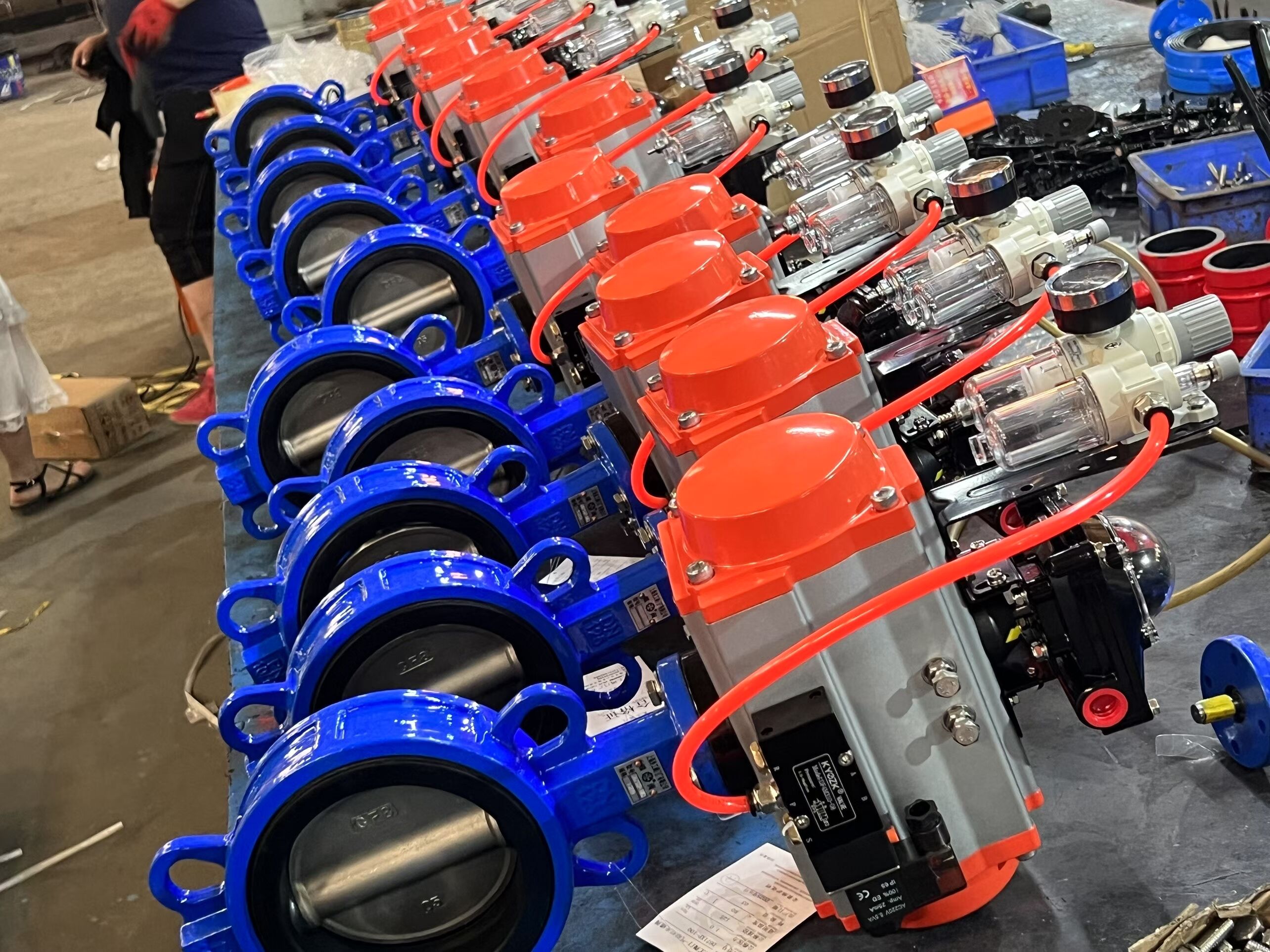Precise and Responsive Flow Control
Smooth and Precise Flow Regulation Through Pneumatic Actuation
Pneumatic butterfly valves provide highly accurate flow control by modulating air pressure, maintaining ±2% flow rate consistency even with high-viscosity fluids (Flow Dynamics Report 2024). Their quarter-turn mechanism allows fine-tuned adjustments—critical in pharmaceutical batch processing and food-grade liquid handling, where valve position changes as small as ±0.5° can impact product uniformity.
Real-Time Modulation in Dynamic Industrial Processes
Today's pneumatic actuators can complete their full stroke movement within just three seconds flat, which means they can make adjustments on the fly when things get hectic. Think about those fast pressure changes happening in pipelines, the way temperatures affect how thick petrochemical mixtures become, or when bottling lines suddenly need to ramp up or slow down production. The quick response time really helps keep everything stable. According to some recent research from plant safety experts in 2024, facilities using these modern actuators saw nearly two-thirds fewer emergency shutdown incidents than plants still relying on old-fashioned manual valves for control.
Integration With Digital Control Systems for Enhanced Accuracy
When integrated with PLC-driven PID loops, pneumatic butterfly valves maintain setpoints within 0.1% deviation—essential for ISO 9001-certified operations. A recent automation upgrade at a major chemical plant demonstrated the performance gap:
| Control Method | Response Time | Energy Savings | Rejected Batches |
|---|---|---|---|
| Manual | 12-45s | - | 8.2% |
| Pneumatic-PLC | 0.8-2.1s | 19% | 0.4% |
This digital compatibility supports predictive adjustments using real-time viscosity sensors and AI-enhanced process models, improving both precision and efficiency.
High Reliability in Demanding Industrial Environments
Pneumatic butterfly valves perform really well even when things get tough. Industry data points to about 98% reliability between temperatures of minus 40 degrees Celsius all the way up to 200 degrees Celsius according to ASME's findings last year. These valves are built using stuff that doesn't corrode easily, think 316L stainless steel bodies paired with those durable PTFE seals. That makes them stand up pretty good against harsh environments where other equipment might fail, especially places like chemical factories or out on oil rigs where saltwater air can eat away at cheaper alternatives over time.
Robust performance in extreme temperatures and corrosive conditions
Sealed actuators and hardened disc designs ensure reliable operation in particulate-laden atmospheres typical of mining and wastewater treatment. Independent testing confirms sustained functionality after more than 10,000 pressure cycles—making them ideal for applications demanding continuous uptime.
Fail-safe operation maintains system safety during power outages
Spring-return mechanisms activate within seconds of air supply loss, preventing overpressure incidents. NFPA 2024 data shows this feature mitigates 85% of such events in power generation systems. Aligned with IEC 61508 functional safety standards, these valves meet rigorous compliance requirements in nuclear and oil refinery operations.
Long-term durability due to simple yet effective mechanical design
With 60% fewer moving parts than motorized valves, pneumatic butterfly variants experience less wear and lower failure rates. A 2023 lifecycle analysis found they require 40% less maintenance over ten years compared to gate valves, achieving over 100,000 operational hours in thermal power plants.
Fast Actuation and Seamless Automation Integration
Sub-second response time enables rapid shutoff in emergencies
Pneumatic butterfly valves run on compressed air and can open or close in under a second, which makes them about 63% quicker compared to similar electric models according to the latest Fluid Control Journal report from 2024. The fast response time really matters when dealing with situations like sudden leaks, unexpected pressure spikes, or potential fire risks that humans just can't react to quickly enough. People working offshore platforms depend heavily on these valves because they stop small problems before they turn into major disasters. A minor valve malfunction might lead to something much worse if not addressed immediately, so having this rapid shut off capability literally saves lives and equipment in critical industrial settings.
Compatibility with PLCs and SCADA systems for full automation
Today's pneumatic actuators connect right into programmable logic controllers using standard protocols such as Modbus RTU, which lets them adjust operations in real time based on what sensors detect. Industrial facilities have found that this kind of system compatibility makes possible all sorts of complicated control sequences. Think about things like slowly increasing flow rates during startup or automatically shutting down equipment when something goes wrong—all without needing anyone to physically intervene. The market now offers pre-wired solenoids that meet NAMUR standards, so they just slot right into most SCADA systems. This means factories can get their automation setups running faster, saving both time and money on installation costs for new production lines.
Low Maintenance and Cost-Efficient Operation
Extended Service Intervals Reduce Downtime and Labor Costs
Pneumatic butterfly valves have a simpler mechanical setup compared to other types, which means they don't wear out as quickly. Most facilities find these valves last between 18 to 24 months before needing attention, way longer than the every three months required for traditional gate valves. Water treatment plants especially benefit from this because it keeps their systems running longer without interruption while saving on labor expenses somewhere around 35 to maybe even 50 percent. According to some research published by the EPA back in 2020, companies that focus on optimizing how they maintain their valves typically see savings anywhere from 5% up to 20% each year just by cutting down on unexpected breakdowns and making smarter use of resources across the board.
Fewer Moving Parts Compared to Electric or Hydraulic Actuators
Pneumatic actuators contain approximately 70% fewer components than electric counterparts, eliminating motors, gearboxes, and lubrication systems. This simplicity reduces maintenance needs by 30–50%, especially beneficial in remote pipeline installations where technician access is limited and repair logistics are costly.
Lifecycle Cost Savings Outweigh Higher Initial Investment
Though pneumatic butterfly valves carry a 15–20% higher initial cost than basic manual valves, their 10–15 year service life results in 40–60% lower total ownership costs. Energy-efficient compressed air operation and avoidance of hydraulic fluid disposal fees further enhance economic returns, particularly in high-cycle processes like pharmaceutical manufacturing.
Compact Design and Wide Application Versatility
Space-saving advantages over gate and globe valves
Pneumatic butterfly valves have this compact disc design that takes up about 40 to 60 percent less room compared to those linear motion gate valves. This makes them really good choices when retrofitting old systems or working in areas where space is at a premium. Globe and gate valves are different because they actually need extra space around them for the stem to extend. Butterfly valves can fit right into those cramped pipe racks and modular skids without any issues. According to folks who know their stuff at Electromate, these valves cut down on structural support expenses by roughly 25 to 35 percent when installed vertically. That kind of savings adds up over time, especially in industrial settings where every inch counts.
Ideal for offshore, modular, and confined installations
These valves typically range from 3 to 15 kilograms based on their size and are made mostly from light weight aluminum mixed with polyamide materials. They work really well on floating platforms as well as those mobile processing setups out at sea. According to a recent 2023 report on fluid controls, around 92 percent of offshore oil companies have started using pneumatic butterfly valves for their seawater intake needs. The main reasons? These valves resist corrosion pretty effectively and can handle about plus or minus thirty degrees of misalignment when pipes move around dynamically in rough ocean conditions.
Proven use in water, wastewater, gas, and air systems
Municipal water networks deploy these valves for chlorination bypass control, reliably handling pressures up to 16 bar (232 psi) with bubble-tight shutoff. In compressed air systems, zero-leakage seats maintain 99.98% efficiency over 100,000 cycles, as validated by ISO 5211 endurance testing.
Compliance with ISO, API, and other industry standards
Leading manufacturers certify pneumatic butterfly valves to key international standards, including ISO 5752 for face-to-face dimensions, API 609 for fire-safe design, and EN 593 for industrial leakage rates. Their streamlined bodies comply with ASME B16.34 pressure ratings while avoiding the protruding flanges common in globe valves, simplifying installation and reducing footprint.
FAQ
What are pneumatic butterfly valves used for?
Pneumatic butterfly valves are used for precise flow control in industries like pharmaceuticals, food processing, water treatment, and petrochemicals. They offer accurate modulation and quick response times for dynamic industrial processes.
How do pneumatic butterfly valves compare to manual valves?
Pneumatic butterfly valves offer quicker response times, enhanced accuracy, and reduced maintenance compared to manual valves. They can also integrate with digital control systems for real-time adjustments.
Are pneumatic butterfly valves suitable for extreme conditions?
Yes, they are highly reliable in extreme temperatures and environments due to their corrosion-resistant materials and robust design, making them ideal for use in harsh industrial settings.
Do pneumatic butterfly valves comply with industry standards?
Yes, they meet various standards such as ISO 5752, API 609, and EN 593. They also adhere to safety standards like IEC 61508 and are certified for fire-safe design.



